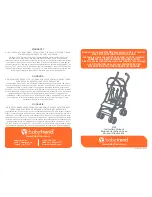
6 N1 70 en
23
4.6
Stroke screw adjustment
1. Limit stop screw (42a, b) can be adjusted to get desired
close & open setting of the valve respectively..
2. With stroke adjustment screw setting of ± 5° can be
achieved in both positions.
3. Loosen nut (43) & rotate stroke adjustment screw in
counter clock wise (CCW) direction to set over travel and
clock wise (CW) direction to set under travel.
4.7
Field conversions
4.7.1
Fail mode reversal (CW to CCW or CCW
to CW)
Step 1.
Remove spring module as per Chapter 4.3 - Section
4.3.1.
Step 2.
Remove pneumatic cylinder module as per Chapter
4.3 - Section 4.3.3.
Step 3.
Re-install the Spring Module onto the opposite end
of central block housing (11), as it was previously located
per Chapter 4.3 - Section 4.3.2.
Step 4.
Re-install the pneumatic cylinder module onto the
opposite end of central block housing (11), as it was previ-
ously located per Chapter 4.3 - Section 4.3.4.
4.7.2
Converting double acting actuator to
spring return
Step 1.
Remove end cap as shown in Chapter 4.3 - Section
4.3.2 step 2 and 4.
Step 2.
If Pneumatic cylinder Module needs to be relocated
due to fail mode requirements (fail counter-clockwise) use
Chapter 4.3 - Section 4.3.3 for removal and Section 4.3.4 for
installation.
Step 3.
Install the Spring Module on the central block hous-
ing (11), as it was previously located per Chapter 4.3 - Sec-
tion 4.3.2.
4.7.3
Converting spring return actuator to
double acting
Step 1.
Remove the Spring module as per Chapter 4.3 - Sec-
tion 4.3.1.
Step 2.
If Pneumatic cylinder Module needs to be relocated
due to fail mode requirements (fail counter-clockwise) use
Chapter 4.3 - Section 4.3.3 for removal and Section 4.3.4 for
installation.
Step 3.
Install end cap as shown onto the opposite end of
central block housing (11).
5
MALFUNCTIONS
Table 4
lists malfunctions that might occur after prolonged use.
Rotate CCW to set over travel
Rotate CCW to set under travel
NOTE:
Actuators must not undergo fail mode reversal without
specific knowledge and acceptance of the resulting
torque output. If a symmetrical yoke is being used during
the process, then fail mode reversal will not affect the
torque output.
Symptom
Possible cause
Action
Irregular or slow operation Low supply pressure
Make sure that supply pressure complies with minimum torque required by
valve. Check that supply air pipes are large enough.
Positioner fault
Check positioner operation.
Valve fault
Check that valve functions properly without actuator.
Incorrect actuator rating
Contact manufacturer to check rating.
Leak in piston or piston rod seal
Replace seals.
Cylinder damaged by impurities
Note installation position recommendation. Replace cylinder if damaged.
Worn-out actuator bearings
Check bearings. Replace bearings when neccessary.
Moving parts corroded in harsh, humid
conditions
Replace the corroded parts.
Backlash in joint between actuator and valve Replace parts as necessary.
Summary of Contents for Neles N1 Series
Page 35: ...6 N1 70 en 35 ...














































